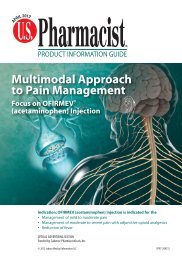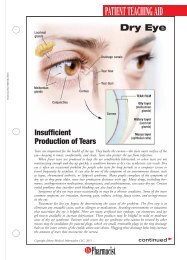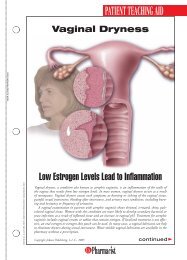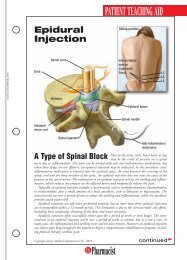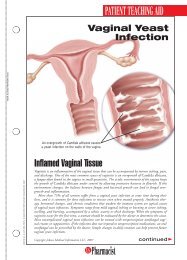View PDF Edition - U.S. Pharmacist
View PDF Edition - U.S. Pharmacist
View PDF Edition - U.S. Pharmacist
You also want an ePaper? Increase the reach of your titles
YUMPU automatically turns print PDFs into web optimized ePapers that Google loves.
EMERGENCY CONTRACEPTION: AN UPDATEappears to have a low failure rate (0.01% to 0.02%),but IUD insertion requires a clinician visit and may notbe suitable for some women. 8 The investigational progesteronereceptor modulator recently approved inEurope, ulipristal, may be as effective with similar sideeffects as levonorgestrel. 14 Studies evaluating the useof levonorgestrel as a single dose (1.5 mg) did not finda significant difference in efficacy compared with 0.75mg two-dose regimens. 7 The newly approved Plan BOne-Step (1.5 mg) is a single-dose regimen that maybe more convenient and easier to use.Table 3Indications for Useof Emergency Contraception• Unprotected intercourse (including forgetting to use acondom or diaphragm)• If a condom breaks or tears during intercourse• Missing one or more doses of an oral contraceptive• Being 2 or 3 days late to resume an ongoinghormonal contraceptive regimen• While taking medication that may reduce theeffectiveness of a hormonal contraceptive• After exposure to a teratogen• After a sexual assaultMechanism of ActionLevonorgestrel, the only active ingredient in Plan B,Plan B One-Step, and Next Choice, is a syntheticprogestin also available in hormonal contraceptives.The mechanisms by which levonorgestrel prevent pregnancyare likely similar to those of other hormonal contraceptives.All currently available hormonal methodsof contraception have been shown to act by one ormore of the following mechanisms: altering the endometriallining, altering cervical mucus, interfering withfertilization or transport of an egg, or preventing implantation.There is good evidence that levonorgestrelprevents or delays ovulation as its primary mechanismof action; however, it is possible that additionalmechanisms may be involved. 15-20 There are no datasupporting the view that levonorgestrel can impair thedevelopment of the embryo or prevent implantation. 20A number of publications have shed light on the mechanismsof action for levonorgestrel-only EC. 15-20 Levonorgestrel-onlyEC has been shown to inhibit the preovulatorysurge of luteinizing hormone (LH), therebyinhibiting follicular development and/or the release ofthe egg. A properly timed and sufficient surge of LH isrequired for the release of an ovum or ovulation. Ovulationmust take place for fertilization to be possible.Research has demonstrated that EC inhibits the midcyclesurge of LH from the pituitary and, if taken at leasttwo days before ovulation, ovulation is delayed or prevented.Ovulation may occur if the administration oflevonorgestrel is delayed until ovulation is imminent. 20If levonorgestrel is taken later in the cycle, the effect onthe LH surge may be equal to that of a placebo and pregnancymay occur. These time-sensitive events may explainwhy taking EC as soon as possible after unprotected intercourseis critical for maximizing its effectiveness.Studies of levonorgestrel and its potential effects onendometrial function have not shown changes that wouldprevent the implantation of a fertilized ovum. 17 Womenwho have used Plan B to prevent a pregnancy early intheir menstrual cycle remain at risk for pregnancy laterin the same cycle if contraception is not resumed or failsagain. This indicates that the endometrium is still intactand capable of implanting a fertilized ovum. 19It has been speculated that levonorgestrel may alterthe movement of a fertilized egg, which would be expectedto increase the risk of an ectopic pregnancy. Studieshave not supported this assumption. The risk of anectopic pregnancy after levonorgestrel use may be slightlylower than national ectopic pregnancy rates. 21 TheCochrane review found only five cases of ectopic pregnancyreported in more than 45,000 uses of EC andconcluded that ectopic pregnancy was not associatedwith any specific type of EC or a likely consequencefrom using EC. 7The International Consortium for Emergency Contraception(ICEC), in a 2008 Policy Statement on mechanismof action, reported that levonorgestrel-only ECpills inhibit, delay, or interfere with ovulation and maypossibly prevent the sperm and egg from meeting byaffecting cervical mucus or the ability of sperm to bindto the egg. 22 The ICEC also stated that there are no directclinical data to support mechanisms other than theinhibition, delay, or alteration of ovulation. 22 LevonorgestrelonlyEC does not cause abortion or interfere with anestablished pregnancy and, if inadvertently taken by awoman who is pregnant, the pregnancy will not be harmed.The ICEC noted that EC might actually prevent abortionsby reducing unplanned pregnancies. 22Indications and ContraindicationsEC is the use of a contraceptive method to prevent pregnancyafter intercourse. Levonorgestrel products areapproved for use within 72 hours after intercourse.There is evidence that taking EC as soon as possiblemay maximize its effectiveness and that use up to 120hours may be effective. Consumers who are unsure ofwhen to use EC or whether EC is needed may ask thepharmacist about its appropriateness. Circumstanceswhere EC is indicated are listed in TABLE 3.<strong>Pharmacist</strong>s can reassure women that EC is safeand effective and can be used when needed to preventpregnancy after unprotected intercourse. A myth thatmay present a barrier to access to EC is belief that itcan only be used once in a lifetime, once per year, or72U.S. <strong>Pharmacist</strong> • November 2009 • www.uspharmacist.com





